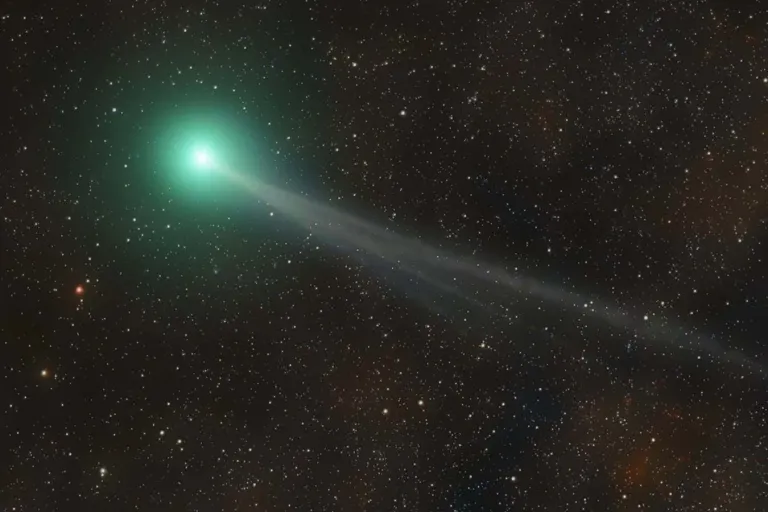In early October 2024, Comet C/2023 A3, better known as Zuqingshan-ATLAS, created a haunting sight as it passed between the Earth and the Sun, providing scientists with a rare and spectacular sight. Discovered in 2023, this comet was captured by the Large Angle and Spectrometry Coronagraph (LASCO) at the U.S. Naval Research Laboratory’s (NRL) Solar Heliospheric Observatory (SOHO).
LASCO tracked the comet for several days, producing stunning images of its journey, especially its massive dust trail that is visible even after the nucleus has moved away.
Comet flyby and solar energy space weather
LASCO principal investigator Carl Battams called the event “one of the most spectacular events we have ever seen” as the dense dust trail coalesced into a unique formation covering the entire field of view. This rare image occurred because the SOHO spacecraft was able to cross the comet’s orbital plane and observe its dust trail from the edge. This phenomenon has never been discussed in such detail before.
Tsuchinshan-ATLAS earned the honor of being the second brightest comet observed by LASCO, reaching magnitude -4.0, although it did not surpass the bright Comet McNaught of 2007. The comet’s passage also opened up a scientific opportunity; because the comet’s dust and gas tails likely interact with solar streams, potentially providing new information about the solar environment and weather of solar space.
Solar flares and striking halos
Around the same time, NRL’s compact coronagraph (CCOR) also made significant progress and collected the first images of coronal mass ejections (CMEs). Launched in June 2024 aboard NOAA’s GOES-19 spacecraft, CCOR is designed to observe the sun’s outer atmosphere, known as the solar corona, by creating an artificial eclipse with a cloaking device that blocks the sun’s glare.
One of the most remarkable observations occurred on October 3, when CCOR recorded the CME halo, a type of solar ejection that appears as a nearly circular shape around the Sun.
This particular CME resulted in visible auroras across much of the northern United States; This is a striking reminder of the Sun’s powerful influence on Earth.
Real-time monitoring of space weather
Another CME halo associated with an active region on the Sun’s surface appeared on October 10, further demonstrating CCOR’s ability to monitor space weather in real time.
“By creating an artificial eclipse, CCOR allows scientists to study the Sun’s corona, which can produce powerful solar storms that can disrupt Earth’s technology,” said research physicist Arnaud Ternissien from NRL. These observations are critically important because they provide early warning of solar storms that could disrupt satellites, communications, and even power grids on Earth.
Understanding comets and solar activity
Recent data collected from Tsuchinshan-ATLAS and CME demonstrate the vital role of the NRL instruments in improving our understanding of both comet and solar activity. The LASCO instrument, which has been in operation for nearly 30 years, continues to play an important role in the study of the Sun and its environment. He also contributes to the Sungrazer Project, a public science initiative responsible for the discovery of more than half of documented comets.
Meanwhile, CCOR-1, the first operational coronagraph in the United States, represents a breakthrough in solar observation. It provides near-real-time data critical to space weather forecasting, allowing scientists to predict and mitigate the effects of solar storms.
This success is just the beginning, with CCOR-2 scheduled to launch in 2025 and the compact coronagraph for the European Space Agency’s Vigil mission in 2031.
The future of space observation
As these advanced devices continue to push the boundaries of space observation, researchers are already looking to the future. Thanks to CCOR’s successful observations of CMEs and LASCO’s continuous monitoring of celestial bodies such as Tsuchinshan-ATLAS, scientists are gaining unprecedented information about the interaction between comets, solar activity, and space weather.
“NRL instruments provide a tremendous amount of information that helps us understand the dynamics of space weather and the broader solar environment,” Ternisien said. he said.
Collaboration between NASA, NOAA, and international partners promises to improve our ability to predict solar storms and understand the fundamental processes shaping our Solar System.
As Comet Tsuchinshan-ATLAS continues its journey into the Oort Cloud and beyond, and CCOR-1 and LASCO closely monitor the Sun, the data collected will be invaluable for future missions and exploration in the ever-evolving space. science.













